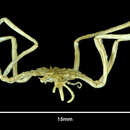en
names in breadcrumbs


“AUSTROPALLENE GRACILIPES n. sp. Figs. 10a, 11a, c and 14c, d.
Distribution:
Sta. 90. 1 young.
Sta. 103. 1 larvigerous male (holotype), 1 female.
Sta. 107. 1 male, 1 female, 1 young.
Description of holotype: The specimen measures 5 mm. in total length, proboscis and abdomen included. The trunk is loosely built, the lateral processes being separated by intervals of at least twice their own diameter, and each has a pair of distal spurs (fig. 10a.). The cephalic somite is rather longer than the sum of the two succeeding segments; the cephalic lobes are small though each bears a large spur; the neck is long. The ocular tubercle is low and wide, and the eyes are conspicuous. The proboscis tapers gradually from base to apex and, in lateral aspect, curves downwards slightly at the tip; it is a little longer than the cephalic somite. The abdomen is short and directed obliquely upwards.
The chelophores are very slender. The scape is at least six times as long as wide. The chela is rather more than half the length of the scape, the palm is twice as long as high and the fingers are of equal length, the immovable one ending in a sharp claw (figs. 10 a and 14 c, d).
The walking legs are, unfortunately, not complete, but it is evident from the proximal half represented in fig. 11 c that they are unusually long and slender. The spurs near the distal articulation of the first coxa are longer than those on the lateral processes. The second coxa is eight times as long as wide and bears three pairs of spinose projections. The femur, which is fifteen times as long as wide*, has no trace of dermal papillae. The first tibia is eighteen times as long as wide, with 3-4 vestigial dermal papillae on the dorsal margin.
*The maximum width, at distal end.
The oviger is also very long and slender (fig. 11 d); there are 15+11+11+10 (47) special spines respectively on the four terminal segments.
Paratypes: The male paratype is rather smaller, but more complete, than the holotype (length = 4.7mm.). The chela is exactly the same but the scape is stouter, being five times as long as wide. There are usually four spinose projections on the second coxa of each leg, a small proximal and distal pair (one of the latter is much larger than the other). The first tibia is somewhat more expanded distally so that the length is only thirteen times the greatest width. There are 4-6 vestigial dermal papillae on the dorsal margin of the second tibia.
The female from Sta. 103 measures 4.5 mm. in total length and is very similar to the male as regards trunk, proboscis and chelophores; the cephalic spurs, however, are much shorter. The third walking leg is represented in fig. 11 a. The second coxa is almost six times as long as wide and bears six spinose projections, the distal and proximal pairs being minute. The femure, like that of the male, shows no trace of dermal papillae; it is eleven times as long as wide and is almost as long as the second tibia. There are 5-8 vestigial dermal papillae on the dorsal margin of each tibia.
Developing ova are present in the femur; it is just possible that the later segment may become wider as the ova increase in size.
Remarks. – This species may easily be distinguished from the other three in division II B of the key by (1) the more slender build, long neck and small cephalic lobes; (2) the unusually long slender walking legs, with scarcely any setae or dermal papillae, and ovigers; (3) the slender chelophore with long narrow chela; and (4) the presence of two spurs on the first lateral process.
The young specimen from Sta. 170, measuring 3-9 mm. in total length, is referred to this species because of the long neck, long slender cephalic spurs and long second coxae of the walking legs. The chela is very immature, with tiny sharp-pointed fingers. Young specimens of A. brachyuran show the adult form of the chela at a much earlier stage than this specimen. It is probable that the adult form of chela and proboscis would be assumed at the next molt.
Distribution: Off the Antarctic Continent, in the Gauss and Victoria Quadrants.” (Gordon 1944, p. 39-41)